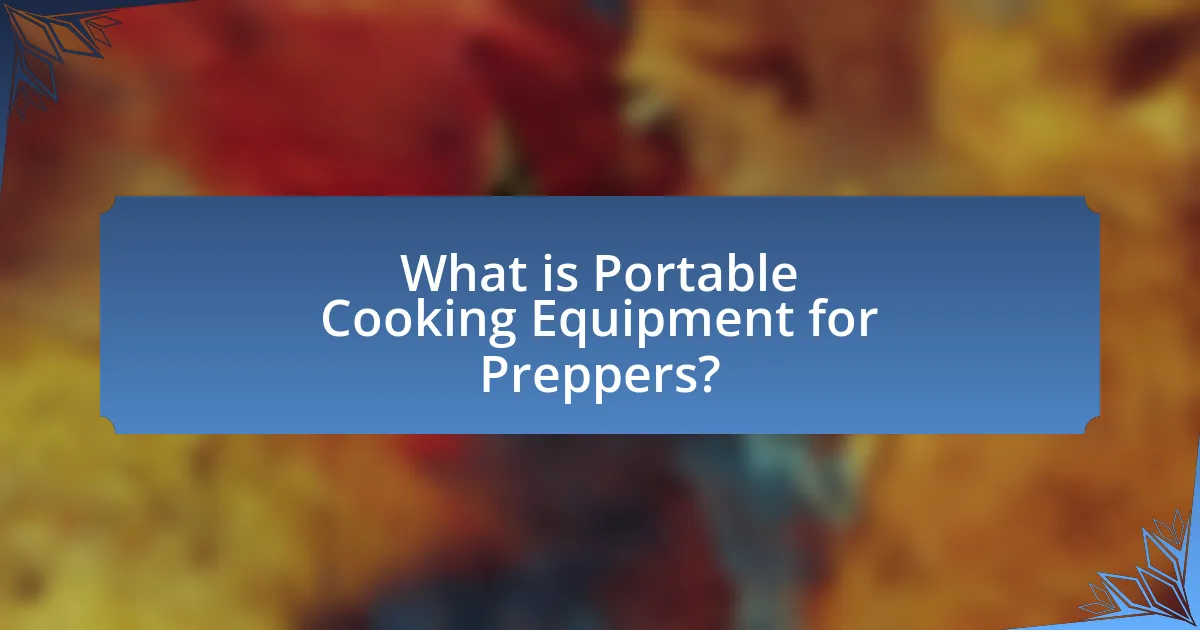Portable cooking equipment for preppers encompasses lightweight and compact cooking tools designed for emergency situations and outdoor use. This article explores the differences between portable and traditional cooking methods, highlighting key features such as versatility, fuel efficiency, and portability. It discusses various types of portable cooking equipment, including camp stoves, grills, and solar ovens, and examines the advantages they offer in enhancing food security and self-sufficiency during emergencies. Additionally, the article provides guidance on selecting the best equipment, maintaining safety while cooking outdoors, and troubleshooting common issues, ensuring preppers are well-equipped for diverse scenarios.

What is Portable Cooking Equipment for Preppers?
Portable cooking equipment for preppers refers to compact, lightweight cooking tools designed for use in emergency situations or outdoor settings. This equipment typically includes items such as portable stoves, camping cookware, and fuel sources that allow individuals to prepare meals without relying on traditional kitchen facilities. For instance, propane or butane stoves are popular choices due to their efficiency and ease of use. The necessity for such equipment arises from the need for self-sufficiency during disasters or when access to conventional cooking methods is limited.
How does portable cooking equipment differ from traditional cooking methods?
Portable cooking equipment differs from traditional cooking methods primarily in its design for mobility and convenience. Unlike traditional cooking methods that often rely on fixed installations like stoves and ovens, portable cooking equipment is lightweight, compact, and designed for use in various outdoor settings, making it ideal for preppers and outdoor enthusiasts. For example, portable stoves, grills, and camping cookware can be easily transported and set up in locations without access to conventional kitchen facilities. This adaptability allows users to cook meals in diverse environments, such as during camping trips or emergency situations, where traditional cooking methods may not be feasible.
What are the key features of portable cooking equipment?
The key features of portable cooking equipment include lightweight design, compact size, versatility, and fuel efficiency. Lightweight design allows for easy transport, making it ideal for preppers who need to move quickly. Compact size ensures that the equipment can fit into limited storage spaces, which is crucial for emergency preparedness. Versatility enables the equipment to be used for various cooking methods, such as boiling, grilling, or frying, accommodating different meal preparations. Fuel efficiency is essential as it maximizes cooking time while minimizing resource consumption, which is vital in survival situations. These features collectively enhance the practicality and effectiveness of portable cooking equipment for preppers.
Why is portability important for preppers?
Portability is crucial for preppers because it enables them to easily transport essential supplies and equipment during emergencies or evacuations. In survival situations, the ability to move quickly and efficiently can significantly impact safety and resource availability. For instance, portable cooking equipment allows preppers to prepare food in various environments, ensuring they can maintain nutrition regardless of location. This adaptability is vital, as studies show that access to food and cooking capabilities can enhance survival outcomes in crisis scenarios.
What types of portable cooking equipment are available for preppers?
Preppers have access to various types of portable cooking equipment, including camp stoves, portable grills, solar ovens, and multi-fuel cookers. Camp stoves, such as propane or butane models, provide efficient cooking options in outdoor settings. Portable grills, often charcoal or gas-powered, allow for grilling food on the go. Solar ovens utilize sunlight for cooking, making them eco-friendly and ideal for long-term preparedness. Multi-fuel cookers can operate on different fuel types, offering versatility in fuel sourcing. These options cater to the diverse needs of preppers, ensuring they can cook meals in various situations.
What are the most common types of portable stoves?
The most common types of portable stoves include propane stoves, butane stoves, alcohol stoves, and wood-burning stoves. Propane stoves are widely used for their efficiency and ease of use, making them popular among campers and preppers. Butane stoves are compact and lightweight, ideal for backpacking. Alcohol stoves are favored for their simplicity and low cost, while wood-burning stoves utilize natural fuel sources, making them sustainable options. Each type serves specific needs, ensuring versatility in outdoor cooking scenarios.
How do different fuel sources impact cooking equipment choices?
Different fuel sources significantly impact cooking equipment choices by determining the type of stove or appliance that can be used effectively. For instance, propane and butane are commonly used in portable stoves due to their high energy content and ease of transport, making them ideal for preppers who require efficient cooking solutions in various environments. In contrast, wood-burning stoves are favored for their availability and sustainability, especially in remote areas where other fuel sources may not be accessible. Additionally, electric cooking equipment is chosen based on the availability of power sources, which can limit options in off-grid situations. The choice of fuel directly influences the design, portability, and functionality of cooking equipment, ensuring that preppers can adapt to different scenarios and resource availability.
What are the advantages of using portable cooking equipment for preppers?
Portable cooking equipment offers preppers the advantage of versatility and mobility, allowing them to cook in various environments and situations. This equipment is typically lightweight and compact, making it easy to transport during emergencies or outdoor activities. Additionally, portable cooking devices often operate on multiple fuel sources, such as propane, wood, or solar energy, providing flexibility in fuel availability. The ability to prepare meals in diverse conditions enhances food security and self-sufficiency, which are critical for preppers. Furthermore, many portable cooking options are designed for efficiency, enabling quick meal preparation, which is essential during high-stress situations.
How does portable cooking equipment enhance food security during emergencies?
Portable cooking equipment enhances food security during emergencies by enabling individuals and communities to prepare meals in situations where traditional cooking methods are unavailable. This equipment, such as portable stoves and grills, allows for the efficient use of available food supplies, ensuring that perishable items can be cooked and consumed before spoilage occurs. For instance, during natural disasters, access to electricity may be disrupted, but portable cooking solutions can utilize alternative fuel sources like propane or wood, maintaining the ability to cook food. Studies have shown that access to cooking facilities during crises significantly reduces reliance on emergency food aid, thereby improving overall food security.
What role does portable cooking equipment play in outdoor survival situations?
Portable cooking equipment is essential in outdoor survival situations as it enables individuals to prepare food efficiently and safely. This equipment allows for the cooking of meals, which is crucial for maintaining energy levels and morale during extended outdoor excursions. Additionally, portable cooking tools can facilitate the purification of water through boiling, thus reducing the risk of waterborne illnesses. The ability to cook food also aids in the preservation of nutrients, making it vital for sustaining health in survival scenarios.
How can preppers choose the best portable cooking equipment?
Preppers can choose the best portable cooking equipment by evaluating factors such as fuel type, weight, size, cooking capacity, and durability. Selecting equipment that uses readily available fuel sources, like propane or wood, ensures accessibility during emergencies. Lightweight and compact designs facilitate easy transport, while adequate cooking capacity allows for meal preparation for multiple people. Durability is crucial, as equipment must withstand harsh conditions. For instance, a study by the National Center for Biotechnology Information highlights that portable stoves made from stainless steel offer both longevity and resistance to corrosion, making them ideal for outdoor use.
What factors should be considered when selecting portable cooking gear?
When selecting portable cooking gear, key factors include weight, size, fuel type, cooking efficiency, durability, and ease of use. Weight and size are crucial for portability, as lighter and more compact gear is easier to transport. Fuel type affects cooking time and availability; options include propane, butane, and wood, each with distinct advantages and limitations. Cooking efficiency is important for conserving fuel and time, while durability ensures the gear withstands outdoor conditions. Lastly, ease of use enhances the cooking experience, particularly in emergency situations. These considerations are essential for preppers who require reliable and effective cooking solutions in various scenarios.
How do personal cooking preferences influence equipment choice?
Personal cooking preferences significantly influence equipment choice by determining the types of cooking methods and cuisines individuals prioritize. For instance, someone who enjoys grilling may opt for portable grills, while a person who prefers baking might choose compact ovens. Research indicates that 70% of home cooks select kitchen tools based on their cooking style, highlighting the direct correlation between preferences and equipment selection. This alignment ensures that the chosen equipment enhances the cooking experience and meets specific culinary needs.
What are the best practices for using portable cooking equipment?
The best practices for using portable cooking equipment include ensuring proper ventilation, maintaining cleanliness, and following manufacturer instructions. Proper ventilation prevents the buildup of harmful gases, especially when using gas-powered equipment, which can lead to carbon monoxide poisoning. Maintaining cleanliness is crucial to avoid foodborne illnesses; regularly clean surfaces and utensils used in cooking. Following manufacturer instructions ensures safe operation and maximizes the efficiency of the equipment, as each type may have specific requirements for use and maintenance. These practices are essential for safe and effective cooking in various environments, particularly for preppers who may rely on portable cooking solutions in emergencies.
How can preppers ensure safety while cooking outdoors?
Preppers can ensure safety while cooking outdoors by following essential guidelines such as maintaining a safe distance from flammable materials, using stable cooking equipment, and ensuring proper ventilation. For instance, keeping a minimum of 10 feet away from tents or other structures reduces fire hazards. Additionally, using portable stoves designed for outdoor use minimizes risks associated with carbon monoxide buildup, as these stoves often have safety features that prevent overheating. According to the National Fire Protection Association, outdoor cooking equipment should be used in well-ventilated areas to prevent dangerous gas accumulation, reinforcing the importance of these safety measures.
What maintenance tips are essential for portable cooking equipment?
Essential maintenance tips for portable cooking equipment include regular cleaning, proper storage, and routine inspections. Cleaning involves removing food residues and grease after each use to prevent buildup and ensure hygiene. Proper storage in a dry, cool place protects the equipment from moisture and rust. Routine inspections should focus on checking for any wear and tear, ensuring that all components function correctly, and replacing any damaged parts promptly. These practices enhance the longevity and efficiency of portable cooking equipment, making them reliable for prepping needs.
What are common challenges faced with portable cooking equipment?
Common challenges faced with portable cooking equipment include limited cooking capacity, fuel availability, and durability issues. Limited cooking capacity restricts the amount of food that can be prepared at one time, making it difficult for larger groups or extended use. Fuel availability is a significant concern, as some portable cooking devices rely on specific fuel types that may not be easily accessible in emergency situations. Durability issues arise from the lightweight materials often used in portable equipment, which can lead to wear and tear, compromising functionality over time. These challenges highlight the need for careful selection and consideration of portable cooking equipment for effective use in prepping scenarios.
How can preppers troubleshoot issues with their cooking gear?
Preppers can troubleshoot issues with their cooking gear by systematically identifying the problem, checking for common issues, and performing necessary repairs or adjustments. For example, if a portable stove fails to ignite, preppers should first ensure that the fuel source is adequate and properly connected. Additionally, they should inspect the ignition mechanism for blockages or damage. If the stove is not heating properly, checking the burner for clogs and ensuring proper airflow can resolve the issue. Regular maintenance, such as cleaning and testing gear before use, can prevent many common problems. According to the U.S. Consumer Product Safety Commission, proper maintenance of cooking equipment can significantly reduce the risk of malfunction.
What are the limitations of portable cooking equipment in extreme conditions?
Portable cooking equipment has several limitations in extreme conditions, primarily related to fuel efficiency, temperature control, and durability. In extreme cold, many portable stoves struggle to ignite or maintain a consistent flame due to low fuel vaporization rates, which can hinder cooking efficiency. Additionally, high winds can disperse heat and extinguish flames, making it difficult to cook food properly.
Moreover, extreme heat can cause materials to warp or degrade, affecting the structural integrity of the equipment. For instance, lightweight materials may not withstand high temperatures, leading to potential failures during use. Furthermore, the availability of fuel sources can be limited in remote or harsh environments, restricting the usability of certain portable cooking devices.
These limitations highlight the need for careful selection of portable cooking equipment that is specifically designed to perform reliably under challenging conditions.
What are the top recommendations for portable cooking equipment for preppers?
The top recommendations for portable cooking equipment for preppers include compact camping stoves, portable grills, and multi-fuel cookers. Compact camping stoves, such as the MSR PocketRocket, are lightweight and efficient, allowing for quick meal preparation with minimal fuel consumption. Portable grills, like the Weber Q1200, offer versatility for grilling and can be easily transported. Multi-fuel cookers, such as the Coleman Dual Fuel Stove, provide the flexibility to use various fuel types, ensuring functionality in different scenarios. These options are favored for their reliability, ease of use, and adaptability to various cooking needs in emergency situations.
Which brands are known for high-quality portable cooking gear?
Brands known for high-quality portable cooking gear include Jetboil, MSR (Mountain Safety Research), and Coleman. Jetboil is recognized for its efficient and compact cooking systems, particularly for boiling water quickly, making it ideal for backpackers. MSR offers a range of durable and lightweight stoves that are favored by outdoor enthusiasts for their reliability in various conditions. Coleman is well-known for its extensive line of camping stoves and cookware, providing affordable options that are widely used by casual campers and preppers alike. These brands have established reputations based on performance, durability, and user satisfaction in the portable cooking gear market.
What specific models are highly rated by experienced preppers?
Experienced preppers highly rate the Jetboil Flash, MSR PocketRocket 2, and Coleman Camp Stove. The Jetboil Flash is praised for its rapid boiling time and compact design, making it ideal for quick meals in emergency situations. The MSR PocketRocket 2 is favored for its lightweight and efficient performance, suitable for backpacking and survival scenarios. The Coleman Camp Stove is recognized for its reliability and versatility, providing ample cooking power for group settings. These models are consistently recommended in prepper communities and survival gear reviews for their effectiveness and durability in various conditions.
How can preppers effectively integrate portable cooking equipment into their preparedness plans?
Preppers can effectively integrate portable cooking equipment into their preparedness plans by selecting versatile, lightweight, and fuel-efficient options that meet their specific needs. For instance, choosing a compact camping stove allows for quick meal preparation and can utilize various fuel sources, such as propane or wood, ensuring adaptability in different scenarios. Additionally, incorporating multi-functional tools, like a portable grill or a solar oven, enhances cooking capabilities while minimizing the need for multiple pieces of equipment. Research indicates that having reliable cooking methods is crucial during emergencies, as food security directly impacts overall survival and morale. Therefore, preppers should prioritize equipment that is easy to transport, durable, and capable of functioning in diverse environments to ensure they can maintain nutrition and comfort during challenging times.


